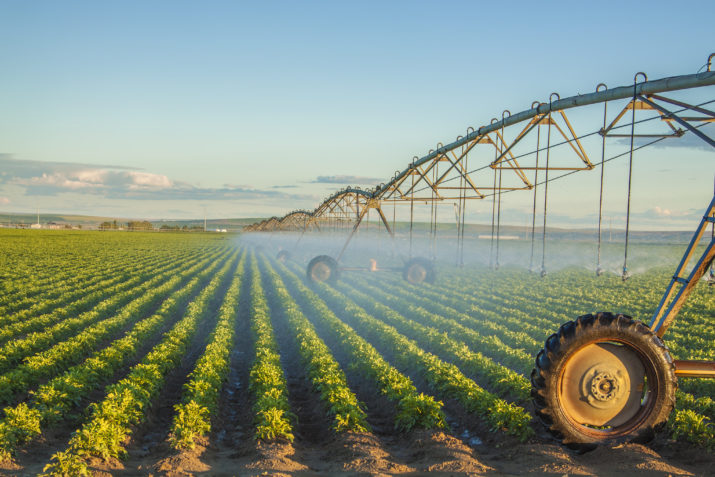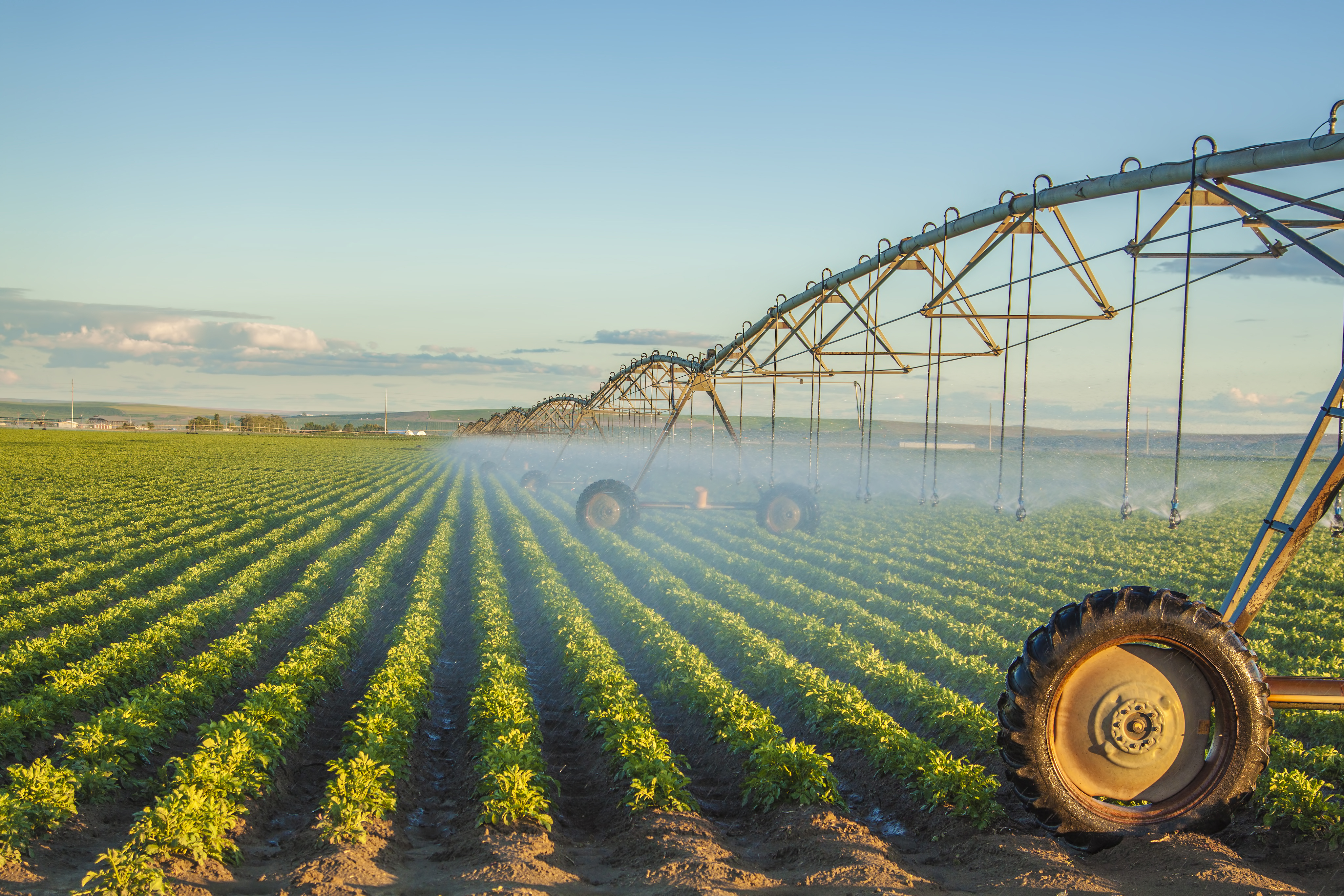

This is part of our special feature on Water in Europe and the World.
Producing the world’s food, feed, fiber, and fuel more sustainably is considered one of the major challenges for humanity today. In 1960, about 0.45 ha (1 acre) of cropland was available for each of the roughly 3 billion inhabitants populating our planet. The per cap availability has halved until 2010 (Figure 1). Of the remaining 0.22 ha, representing a square of the size 47 m x 47 m, only about 22 percent are used to grow crops for direct human consumption while 61 percent of the square is needed to produce fodder crops for livestock, and 17 percent to produce biofuels and fibers. Nevertheless, per cap food supply in terms of calories has increased by 30 percent within this period, which means that food production increased faster than population [3]. This enhancement could only be achieved by intensifying agricultural production, in particular, by an increased application of agrochemicals (the global use of N-fertilizer increased ten times in this period), and by doubling the extent of irrigated lands and of the associated water use for irrigation. It is estimated that cereal crop yields on irrigated land doubled in comparison to yields achieved on the same land under rainfed conditions. In addition, crop yields on irrigated land are less affected by drought and therefore more stable than yields on rainfed land, especially in arid or semi-arid regions. Irrigation therefore contributes considerably to food security by stabilizing crop production in dry years, which is especially important for developing countries not well integrated into the world market.

Figure 1
If water and soil resources are not well managed, water use for irrigation can negatively affect ecosystems and water availability for other water use sectors. Globally, irrigation is by far the largest water use sector and contributes to about 90 percent of the additional evapotranspiration caused by human water use [2]. Water is a renewable resource circulating in the global hydrological cycle—it cannot be used up. Therefore, the total volume of water use is only a weak sustainability indicator. More important is the question of where and when the water is used. Irrigation water requirements are high in periods of drought, when the soil water storage is depleted, or in arid regions, where precipitation is low in general. Therefore, the highest water demand often coincides with water scarcity, resulting in water stress. Critical impacts are declining groundwater tables, rivers that run dry, shrinking lakes or empty reservoirs. If droughts persist for longer times, shortage in irrigation water supply results in declining crop yields and declining crop areas. Drought events with high impacts are observed frequently in semi-arid regions, such as California or Southern Africa, but even in more humid regions, such as Western Europe, droughts caused big economic losses, for example in year 2003, and in the summer of 2018.
It is not only this large volume of water extracted from groundwater or surface water bodies that raised concerns about the sustainability of the freshwater use for irrigation, but also the huge water supply infrastructure needed for that purpose. It is estimated that 17 million reservoirs with a surface larger than 0.5 million km2 have been constructed for water supply and energy production [7], many of them for irrigation. Assuming that the reservoirs are, on average, filled to half of their capacity, the annual evaporation from the surface of these artificial lakes was estimated at 346 km3 of water which is more than the consumptive water use for industry, households and livestock together [5]. In addition, dam construction affects most of the big rivers by extensive flow regulation so that their discharge dynamics differ considerably from natural conditions. Because of the high costs for the supply infrastructure, their big environmental impact, and because of the relatively low water use efficiency, the construction of big irrigation schemes supplied with water from reservoirs or rivers has been increasingly challenged in the last decades. Irrigation can also have negative impacts on soil quality when rising groundwater tables result in enrichment of salts in the soil profile. This is usually due to missing drainage infrastructure that could be used to control groundwater tables and to wash out salts accumulating in the soil.
Irrigation with groundwater has developed as an alternative in many regions, with water use efficiencies being often higher in groundwater irrigation. The water extraction point is usually closer to the irrigated fields, which makes distribution losses less likely. Another reason for the recent rise of groundwater irrigation is that farmers can operate more independently and pump the water when it is needed. This flexibility and independency can become a disadvantage when many thousand farmers pump the water from the same aquifer. Then water extraction is difficult to monitor and to control bearing the risk of overexploitation of the aquifer. Declining groundwater tables indicate then that aquifer recharge is smaller than the water extraction. Water previously stored in the aquifer is released to the atmosphere and will sooner or later accumulate in the world’s oceans. Therefore, even 13 percent of the sea level rise in period 2000-2008 was attributed to the mobilization of water by groundwater depletion [6].
Pathways to more sustainable water use for irrigation
There are many examples, such as desert or mountain oases, proving that irrigated agriculture can be sustained for millennia, even under very arid climate conditions without deteriorating soil and water resources. However, some technological principles need then to be considered. In areas potentially affected by salinity, agricultural drainage is essential. There are many technologies that can be used, from simple ditches to tile drainage or man-made terraces with gravel below the soil profile acting as drainage layer. It’s important, then, to ensure that canals conveying drainage water are kept separate from canals distributing irrigation water. Advanced systems of this type can be found, for example, in the river Nile basin in Egypt. Many of the traditional irrigation systems on the flood plains along the major rivers are characterized by shallow aquifers. Groundwater tables can then be controlled by conjunctive use of groundwater and surface water when farmers have access to both water sources. Using predominantly surface water (e.g. canal water) results in rising groundwater tables, while extracting groundwater is causing declining groundwater tables. A good balance can maintain a groundwater table deep enough to avoid salinization and high enough to supply natural vegetation with water, and to allow easy water extraction from wells. An additional advantage of conjunctive use is that the water supply is more reliable because farmers can switch to groundwater pumping in periods when canal water is not available. Conjunctive use is already established in many irrigation areas in India and Pakistan, where statistics on the volumes of freshwater used from different sources for irrigation differ considerably so that the true extent of this practice at the ground is difficult to quantify. Improved irrigation technology may also help to reduce water requirements by increasing the efficiency of irrigation water use and by reducing non-productive losses. The most advanced technologies such as drip irrigation systems are successfully being applied in orchards, vineyards, horticulture, and for some row crops. Because these systems are costly, farmers use them mainly when there are restrictions in water supply so that saving water is essential. However, not in any case implementing these modern technologies also results in water savings at farm or regional level. Often water savings at field level are used to expand the irrigated area so that the total water abstraction remains similar.
More recently, other strategies to save water going beyond technological solutions are increasingly discussed and considered. For example, irrigation water use can be reduced by virtual water trade, when local products requiring high volumes of irrigation water are replaced by imports of products from regions where agriculture is rainfed, or where the efficiency of irrigation water use is higher. In fact, many regions worldwide, such as highly populated regions or settlements in arid regions, rely on virtual water imports because the water resources to produce the goods consumed in these regions are not available locally. Related to this is the water footprint concept, which is used to quantify the volume of water needed to produce a good or to provide a service. For example, about 1760 liters of water are needed every day to produce 19 major crop commodities consumed by each citizens of Berlin, much more than the drinking water consumption of about 121 liters per day. The average distance of the production regions is more than 4000 km, which is even outside Europe, demonstrating that the city is highly integrated into global trade flows [4]. The consumption of products in Berlin has therefore considerable impact on the water use in the production regions far away.
Studies calculating virtual water balances for all of Europe show that the European Union is a net importer of virtual water contained in agricultural products, but there are also considerable virtual water flows between European countries (Table 1). The major exporters of virtual blue (irrigation) water are Spain and France, while the major importers are Germany and the UK. Therefore, in Europe, blue virtual water is flowing from water scarce regions to regions in which water resources are more abundant. Flows of green water, that is rainfall stored in the soil and used by plants to grow, do not compensate for the flows of blue water [1]. Consequently, there is an increasing debate how consumption patterns can contribute to more sustainable production processes. While it is already difficult to calculate water footprints of complex, processed products, it is even more challenging to quantify impacts that the water use for a specific good may have in the production region [8]. Different dimensions, such as environmental impacts, socio-economic impacts, or institutional impacts would need to be considered and to be compared which raises methodological questions. Also, consumers may assign distinct weights to these dimensions adding a subjective component which may change in time. These difficulties might be the major reason why water footprints and virtual water flows calculated by using live cycle assessment methods did not result so far in simple labels for sustainable water use in crop production.
A European perspective on the sustainability of irrigation
To postulate an European perspective on the sustainability of water use, in particular for irrigation, is challenging because of the diversity of the conditions at the ground. There are many regions in Northern and Western Europe where water resources are abundant and regions mainly in the South of Europe exposed to water scarcity and seasonal shortages in water supply. Consequently, people have distinct perspectives on water use and the need to save water. However, there are also some aspects that are specific to Europe and that are shared by the Europeans.
For example, most of the European countries are small. That’s why all bigger streams are trans-boundary and even many of the major aquifers are shared by several countries. Any water use or water pollution upstream therefore also affects people in other countries downstream. This is a potential source of conflict, but it also stimulates collaboration. The management of water resources included therefore always to consider interests of downstream users in other nations fostering international agreements. One example for this transboundary perspective is the Water Framework Directive of the European Commission, which is currently implemented in all member states of the European Union. Based on an assessment of quality and quantity of groundwater and surface water resources, integrated river basin management plans are designed and implemented with the objective to improve water quality and to ensure water availability, also for downstream users. Considering impacts of own water resource use on water availability and water quality far away has therefore some tradition and may also explain the strong presence of the water footprint in the public discussion.
Another aspect that is common in Europe is the relative scarcity of land resources available for agricultural production. The fertile soils have been used for crop production already for a very long time and the potential to expand agricultural land has always been very limited. Therefore a strong focus has been on improving and maintaining soil fertility to maximize the productivity of agricultural land. This included extensive drainage works and measures to improve the availability of nutrients. Irrigation also has a long tradition in many parts of Europe [9] but the motivation to introduce irrigation varied between the more humid regions in northern, western and eastern Europe and the southern part of Europe, which is more frequently affected by drought. Irrigation of field crops is traditionally being used in southern Europe since ancient time but does not have a long tradition in the northern part of Europe. It was introduced in the northern part of Europe more recently after the WWII. Before that period, irrigation was used mainly to water meadows to produce more reliably fodder for livestock. Interestingly, irrigation was often applied in the late winter period and in early spring to advance the re-growth of vegetation and to fertilize the meadows with minerals and urban sewage contained in the irrigation water. The largest extent of meadow irrigation was observed in the eighteenth and nineteenth century before synthetic fertilizers were introduced. Today meadow irrigation is still present in some regions such as Switzerland, northern Italy, the Netherlands or UK but the traditional flood irrigation practice has been replaced almost everywhere by sprinkler irrigation systems. The main reason for irrigating meadows today is to ensure fodder production in dry periods but the extent of irrigated field crops is meanwhile much larger in most regions of Europe. What remains is the strong focus on soil fertility as a prerequisite for sustainable land and water use. Something that is positive and would certainly be nice to share with farmers and irrigation planers active in other world regions.
| 1993 – 2000 | 2001 – 2011 | |
| From EU to EU countries | 14.73 | 22.76 |
| From EU to non EU countries | 9.05 | 7.56 |
| From non EU to EU countries | 18.68 | 15.14 |
| Net importers and exporters in intra EU/EFTA blue virtual water trade (1993 – 2011) | ||
| Net imports Germany | 1.5 | |
| Net imports UK | 1.2 | |
| Net exports Spain | 4.2 | |
| Net exports France | 1.2 | |
Table 1. Annual agricultural blue virtual water flows to/from the EU and net flows for the major importing and exporting countries in period 1993 to 2011 (km3 yr-1). Data obtained from [1].
Stefan Siebert is Professor of Crop Scince / Agronomy at the Department of Crop Sciences, Georg-August-Universität Göttingen, Germany. He obained a MSc and PhD degree in Agricultural Sciences from University of Kassel and habilitated at University of Bonn. His expertise is mainly in Agronomy, Environmental Science and Geoscience focusing on strategies for sustainable resource use and management in plant production. Specific emphasis is on water and nutrient management. Another research focus is on the impact of abiotic stress (heat, drought) on crop growth, development and productivity. He collaborates for more than 2 decades with FAO on the development and maintanence of the Global Map of Irrigation Areas (http://www.fao.org/nr/water/aquastat/irrigationmap/index.stm).
References:
[1] Antonelli M, Tamea S and Yang H 2017 Intra-EU agricultural trade, virtual water flows and policy implications Science of the Total Environment 587-588 439-48
[2] Doell P, Hoffmann-Dobrev H, Portmann F T, Siebert S, Eicker A, Rodell M, Strassberg G and Scanlon B R 2012 Impact of water withdrawals from groundwater and surface water on continental water storage variations J Geodyn 59-60 143-56
[3] FAO 2018 FAOSTAT. FAO, Rome, Italy (http://www.fao.org/faostat/en/#home)
[4] Hoff H, Döll P, Fader M, Gerten D, Hauser S and Siebert S 2014 Water footprints of cities – indicators for sustainable consumption and production Hydrology and Earth System Sciences 18 213-26
[5] Kohli A and Frenken K 2015 Evaporation from artificial lakes and reservoirs. FAO, Rome, Italy (http://www.fao.org/3/a-bc814e.pdf)
[6] Konikow L F 2011 Contribution of global groundwater depletion since 1900 to sea-level rise Geophys Res Lett 38
[7] Lehner B, Liermann C R, Revenga C, Vorosmarty C, Fekete B, Crouzet P, Doll P, Endejan M, Frenken K, Magome J, Nilsson C, Robertson J C, Rodel R, Sindorf N and Wisser D 2011 High-resolution mapping of the world’s reservoirs and dams for sustainable river-flow management Front Ecol Environ 9 494-502
[8] Manson L and Epps T 2014 Water Footprint Labelling and WTO Rules Review of European, Comparative & International Environmental Law 23 329-41
[9] Siebert S, Kummu M, Porkka M, Döll P, Ramankutty N and Scanlon B R 2015 A global data set of the extent of irrigated land from 1900 to 2005 Hydrol. Earth Syst. Sci. 19 1521-45
Photo: potato field irrigated by a pivot sprinkler system | Shutterstock
Published on December 11, 2018.




